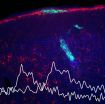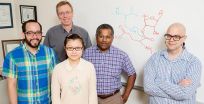Real-time readout of neurochemical activity
Engineered cells reveal changes associated with learning, memory and reward
2014-10-26
(Press-News.org) Scientists have created cells with fluorescent dyes that change color in response to specific neurochemicals. By implanting these cells into living mammalian brains, they have shown how neurochemical signaling changes as a food reward drives learning, they report in Nature Methods online October 26.
These cells, called CNiFERs (pronounced "sniffers"), can detect small amounts of a neurotransmitter, either dopamine or norepinephrine, with fine resolution in both location and timing. Dopamine has long been of interest to neuroscientists for its role in learning, reward, and addiction.
"Dopamine is a ubiquitous molecule in the brain that signals 'mission accomplished.' It serves as the key indicator during almost all aspects of learning and the formation of new memories," said David Kleinfeld professor of physics at UC San Diego, who directed the work. "Disruptions to dopamine signaling lie at the heart of schizophrenia and addiction." Kleinfeld also holds appointments in neurobiology, and electrical and computer engineering.
Neuroscientists have long sought to measure dopamine in the brain during controlled conditions. But the chemistry of dopamine is so close to that of norepinephrine that fast and accurate measurements of dopamine, not confounded by other molecules, have eluded scientists.
Kleinfeld and Paul Slesinger, a professor of neuroscience at Icahn School of Medicine at Mount Sinai, New York, developed CNiFERs to meet this challenge. These modified cells can be inserted into the brains of animals to observe changes in neural signalling in real time.
Arnaud Muller and Victory Joseph, working Kleinfeld's laboratory, implanted CNiFERs into the frontal cortex in mice, then watched how signaling changed as the mice learned to associate a sound with a sweet reward.
This is classical conditioning, in which a tone that reliably preceded a drop of sweet water came to elicit anticipatory licking over time. The researchers found that release of dopamine, but not norepinephrine, tracked this change. That is, dopamine was initially released with the reward, but began to be released earlier, with the tone, as the mice learned to associate this previously neutral signal with something pleasant. In mice that failed to learn or made only a weak association, the anticipatory release of dopamine was reduced as well.
Brain researchers have long suspected this link. But because the design of these cellular reporters is quite versatile, a number of different chemical signals of interest could be tracked using the same approach.
"This work provides a path for the design of cells that report a large and diverse group of signaling molecules in the brain," Kleinfeld said.
INFORMATION:
The National Institute on Drug Abuse, National Institute of Biomedical Imaging and Bioengineering and Hoffman-La Roche provided funding for this work.
[Attachments] See images for this press release:

ELSE PRESS RELEASES FROM THIS DATE:
2014-10-26
Lasers – devices that deliver beams of highly organized light – are so deeply integrated into modern technology that their basic operations would seem well understood. CD players, medical diagnostics and military surveillance all depend on lasers.
Re-examining longstanding beliefs about the physics of these devices, Princeton engineers have now shown that carefully restricting the delivery of power to certain areas within a laser could boost its output by many orders of magnitude. The finding, published Oct. 26 in the journal Nature Photonics, could allow ...
2014-10-26
NEW YORK, NY (October 26, 2014)—Dietary cocoa flavanols—naturally occurring bioactives found in cocoa—reversed age-related memory decline in healthy older adults, according to a study led by Columbia University Medical Center (CUMC) scientists. The study, published today in the advance online issue of Nature Neuroscience, provides the first direct evidence that one component of age-related memory decline in humans is caused by changes in a specific region of the brain and that this form of memory decline can be improved by a dietary intervention.
As ...
2014-10-26
MOUNT WILSON, Calif.–Astronomers at Georgia State University's Center for High Angular Resolution Astronomy (CHARA) have observed the expanding thermonuclear fireball from a nova that erupted last year in the constellation Delphinus with unprecedented clarity.
The observations produced the first images of a nova during the early fireball stage and revealed how the structure of the ejected material evolves as the gas expands and cools. It appears the expansion is more complicated than simple models previously predicted, scientists said. The results of these observations, ...
2014-10-26
BOSTON –– Scientists say they have identified in about 20 percent of colorectal and endometrial cancers a genetic mutation that had been overlooked in recent large, comprehensive gene searches. With this discovery, the altered gene, called RNF43, now ranks as one of the most common mutations in the two cancer types.
Reporting in the October 26, 2014 edition of Nature Genetics, investigators from Dana-Farber Cancer Institute and the Broad Institute of MIT and Harvard said the mutated gene helps control an important cell-signaling pathway, Wnt, that has been ...
2014-10-26
Why do we remember some things and not others? In a unique imaging study, two Northwestern University researchers have discovered how neurons in the brain might allow some experiences to be remembered while others are forgotten. It turns out, if you want to remember something about your environment, you better involve your dendrites.
Using a high-resolution, one-of-a-kind microscope, Daniel A. Dombeck and Mark E. J. Sheffield peered into the brain of a living animal and saw exactly what was happening in individual neurons called place cells as the animal navigated a virtual ...
2014-10-26
Digoxin, a medication used in the treatment of heart failure, may be adaptable for the treatment of amyotrophic lateral sclerosis (ALS), a progressive, paralyzing disease, suggests new research at Washington University School of Medicine in St. Louis.
ALS, also known as Lou Gehrig's disease, destroys the nerve cells that control muscles. This leads to loss of mobility, difficulty breathing and swallowing and eventually death. Riluzole, the sole medication approved to treat the disease, has only marginal benefits in patients.
But in a new study conducted in cell cultures ...
2014-10-26
CHAMPAIGN, Ill. — Researchers report in the journal Nature that they have made a breakthrough in understanding how a powerful antibiotic agent is made in nature. Their discovery solves a decades-old mystery, and opens up new avenues of research into thousands of similar molecules, many of which are likely to be medically useful.
The team focused on a class of compounds that includes dozens with antibiotic properties. The most famous of these is nisin, a natural product in milk that can be synthesized in the lab and is added to foods as a preservative. Nisin has ...
2014-10-24
Most of the concerns about climate change have focused on the amount of greenhouse gases that have been released into the atmosphere.
But in a new study published in Science, a group of Rutgers researchers have found that circulation of the ocean plays an equally important role in regulating the earth's climate.
In their study, the researchers say the major cooling of Earth and continental ice build-up in the Northern Hemisphere 2.7 million years ago coincided with a shift in the circulation of the ocean – which pulls in heat and carbon dioxide in the Atlantic ...
2014-10-24
DENVER – A better survival outcome is associated with low blood levels of squamous cell carcinoma antigen, or absence of tumor invasion either into the space between the lungs and chest wall or into blood vessels of individuals with a peripheral squamous cell carcinoma, a type of non-small cell lung cancer (NSCLC).
Lung cancer is the most common cause of cancer-related death worldwide and lung squamous cell carcinomas (SCC) account for 20-30% of all NSCLC. SCC can be classified as either central (c-SCC) or peripheral (p-SCC) depending on the primary location. While ...
2014-10-24
VIDEO:
On Oct. 23, while North America was witnessing a partial eclipse of the sun, the Hinode spacecraft observed a 'ring of fire' or annular eclipse from its location hundreds of...
Click here for more information.
The moon passed between the Earth and the sun on Thursday, Oct. 23. While avid stargazers in North America looked up to watch the spectacle, the best vantage point was several hundred miles above the North Pole.
The Hinode spacecraft was in the right place at the ...
LAST 30 PRESS RELEASES:
[Press-News.org] Real-time readout of neurochemical activity
Engineered cells reveal changes associated with learning, memory and reward







